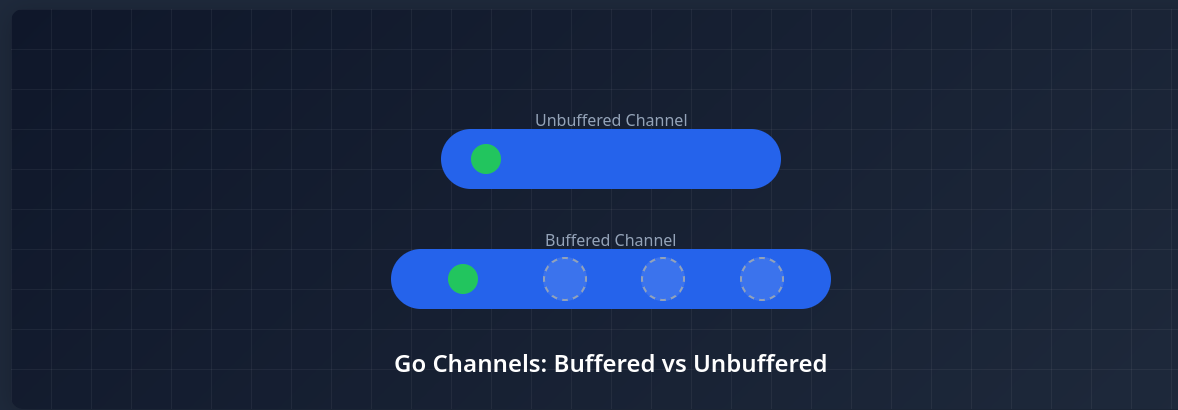Introduction
Go's channel system is one of its most powerful features for handling concurrent operations. Understanding the difference between buffered and unbuffered channels is crucial for writing efficient concurrent programs. In this article, we'll explore both types of channels, their behaviors, use cases, and best practices.
Understanding Channels: The Basics
Before diving into the differences, let's briefly review what channels are in Go:
// Unbuffered channel ch := make(chan int)
// Buffered channel with capacity of 3 bufferedCh := make(chan int, 3)
Channels are typed conduits that allow goroutines to communicate with each other. They act as pipes that can transmit data between concurrent processes.
Unbuffered Channels: Synchronous Communication
Unbuffered channels, also known as synchronous channels, provide a direct communication link between goroutines. Here's their key characteristic:
package main
import (
"fmt" "time" )
func main() {
ch := make(chan string)
go func() {
fmt.Println("Starting to send data...")
ch <- "Hello" // This will block until receiver is ready fmt.Println("Data sent!")
}()
time.Sleep(2 * time.Second) // Simulate work fmt.Println("Ready to receive")
msg := <-ch
fmt.Println("Received:", msg)
}
Key Properties of Unbuffered Channels:
- Sending blocks until there's a receiver
- Receiving blocks until there's a sender
- Perfect for synchronization between goroutines
- Guarantees that data has been received when send completes
Buffered Channels: Asynchronous Communication
Buffered channels include a capacity for storing elements:
package main
import (
"fmt" )
func main() {
ch := make(chan string, 2)
ch <- "First" // Won't block ch <- "Second" // Won't block // ch <- "Third" // This would block - buffer full
fmt.Println(<-ch) // First fmt.Println(<-ch) // Second }
Key Properties of Buffered Channels:
- Sending only blocks when the buffer is full
- Receiving only blocks when the buffer is empty
- Provides temporary storage between sender and receiver
- Allows for some decoupling of goroutines
Performance Considerations
Let's look at a practical example comparing both types:
package main
import (
"fmt" "time" )
func bufferPerformanceTest() {
start := time.Now()
// Buffered channel buffCh := make(chan int, 1000)
go func() {
for i := 0; i < 1000; i++ {
buffCh <- i
}
close(buffCh)
}()
for range buffCh {
// Just drain the channel }
fmt.Printf("Buffered took: %v\n", time.Since(start))
}
func unbufferPerformanceTest() {
start := time.Now()
// Unbuffered channel unbuffCh := make(chan int)
go func() {
for i := 0; i < 1000; i++ {
unbuffCh <- i
}
close(unbuffCh)
}()
for range unbuffCh {
// Just drain the channel }
fmt.Printf("Unbuffered took: %v\n", time.Since(start))
}
func main() {
bufferPerformanceTest()
unbufferPerformanceTest()
}
When to Use Each Type
Use Unbuffered Channels When:
- You need guaranteed delivery
- You want synchronization between goroutines
- You're implementing a request-response pattern
- You need to ensure processing happens in a specific order
Use Buffered Channels When:
- You want to decouple sending and receiving operations
- You're dealing with bursty data
- You want to implement a producer-consumer pattern with some buffering
- You need to prevent goroutine blocking in specific scenarios
Common Patterns and Examples
Producer-Consumer Pattern with Buffered Channel:
package main
import (
"fmt" "time" )
func producer(ch chan<- int) {
for i := 0; i < 5; i++ {
ch <- i
fmt.Printf("Produced: %d\n", i)
}
close(ch)
}
func consumer(ch <-chan int) {
for num := range ch {
fmt.Printf("Consumed: %d\n", num)
time.Sleep(time.Second) // Simulate processing }
}
func main() {
ch := make(chan int, 3) // Buffer size of 3
go producer(ch)
consumer(ch)
}
Best Practices and Common Pitfalls
- Buffer Size Selection:
// Don't arbitrarily choose buffer sizes ch := make(chan int, 100) // Avoid magic numbers
// Do choose based on expected load const bufferSize = 100 ch := make(chan int, bufferSize)
- Proper Channel Closing:
func safeClose(ch chan int) {
defer func() {
if r := recover(); r != nil {
fmt.Println("Attempted to close closed channel")
}
}()
close(ch)
}
- Deadlock Prevention:
func badPattern() {
ch := make(chan int)
ch <- 1 // Deadlock! No receiver }
func goodPattern() {
ch := make(chan int)
go func() {
ch <- 1 // Good: sender in separate goroutine }()
<-ch
}
Memory Considerations
Buffered channels consume memory proportional to their capacity. Here's a simple demonstration:
package main
import (
"fmt" "runtime" )
func memoryUsage() uint64 {
var m runtime.MemStats
runtime.ReadMemStats(&m)
return m.Alloc
}
func main() {
before := memoryUsage()
// Create a large buffered channel ch := make(chan int, 1000000)
after := memoryUsage()
fmt.Printf("Memory used: %d bytes\n", after-before)
}
Conclusion
The choice between buffered and unbuffered channels depends on your specific use case:
- Unbuffered channels provide strong synchronization guarantees and are ideal for direct communication between goroutines.
- Buffered channels offer more flexibility and can improve performance in certain scenarios, but require careful consideration of buffer size and memory usage.
Remember that both types have their place in Go programming, and understanding their characteristics helps you make the right choice for your specific needs.
